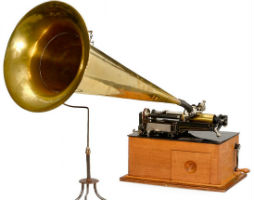
ELIZABETH CITY, N.C. (AP) – Ed Fearing placed a shellac composite record on his 1905 Victor phonograph. He cranked the handle, and Poet and Peasant Overture began, at first a little slow and distorted, then quickly catching up to normal speed. The music boomed into his living room.
There was no volume control in 1905, so people would stuff socks in the big horn hovering over the phonograph’s turntable to soften the sound, Fearing said.
“I don’t have a sock handy, but I do have a towel,” he said, pushing it into the horn. The music softened.
“And that’s where they get the saying, ‘Put a sock in it,’” he said.
At one time, Fearing owned more than 150 old phonographs or gramophones and about 10,000 records from the early 20th century. He kept them in a building where he lived in rural Pasquotank County.
He had to downsize two years ago, selling much of his collection at auction, but what remains is still impressive: 30 phonographs and about 1,000 records.
“When you’re a collector, you’re a historian, and when you’re a historian, you’re a collector,” said Fearing, 61, who is also a schoolteacher.
His large, old home in downtown Elizabeth City is a veritable museum to the phonograph’s history. Models of different makes and sizes sit in all corners. Some are topped with wide-mouthed horns, while later models have the horns enclosed in a cabinet, like modern speakers.
Thomas Edison invented the phonograph in 1877. At first, recordings were played on cylinders. Emile Berliner gets credit for developing flat disks.

The Victor company became Victrola after cabinets hid the horn, Fearing said. As the technology evolved, industry heavyweights including Victrola’s owner, Eldridge Johnson, and Edison competed over upgrades, often going to court over copyright complaints.
Edison used a round-point diamond stylus that floated over a “hill and dale” disk, while Victor used a needle that traveled in V-shaped grooves. Johnson got a patent on closing cabinet doors to turn the sound down, while Edison patented his own newfangled volume control. Fearing can demonstrate it on his own Edison model: Sliding the control switch back and forth moves a big soft ball in and out of the horn.
The phonograph makers made their own records and hired freelance singers, Fearing said, pulling out a quarter-inch-thick record made of wood. Sliding it onto the appropriate phonograph, Fearing explained it was Lucky Lindy, a late 1920s tune by Vernon Dalhart celebrating Charles Lindbergh’s famous flight across the Atlantic Ocean.
“Lucky Lindy! Up in the sky/Fair or windy, he’s flying high,” the record played.
A neighbor gave Fearing his first Brunswick phonograph when he was boy. He played it on the front porch until it wouldn’t play anymore.
“I was fascinated with anything that did not use electricity,” Fearing said.
Later he bought more phonographs, traveling to distant states in some cases. He studied manuals and learned to make repairs. Another collector taught him detailed fixes to needle diaphragms and other intricate parts.
Most old phonographs sell for under $100 now, he said. The 2008 market slump and declining interest in antiques pushed prices down.
An Edison phonograph called an an Adams 18th Century Model, because of the vintage woodwork, stands against his dining room wall. It was made in 1922 at a cost of $450, equivalent to $8,000 in today’s money, Fearing said.
“It was for the wealthy,” he said. “You could buy a new car for $600.”
Fearing found it for sale in Pennsylvania, sitting in a basement, dirty and in bad condition. He repaired and cleaned it. It sounded good as new last week, as he placed a record on the turntable. Mike Speciale and his band played Bam Bam Bamy Shore – a good number for dancing the fox trot.
“These things were state of the art when they were created,” Fearing said. “It was so revolutionary at the time.”
Click to browse Vintage Radios and Audio Equipment and the offspring forms of entertainment that came in the century to follow.
___
By JEFF HAMPTON, The Virginian-Pilot
Information from: The Virginian-Pilot, http://pilotonline.com
Update on February 16, 2018: This story was fact-checked by the Associated Press, and key elements are corroborated by The Mirror, Wiktionary, and History Revealed.
Copyright 2016 Associated Press. All rights reserved. This material may not be published, broadcast, rewritten, or redistributed.
AP-WF-10-19-16 1926GMT



